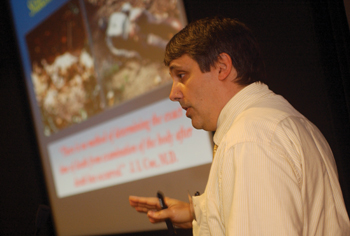
Oak Ridge National Laboratory’s Arpad Vass, Ph.D.
photo by Dana Johnson
Symposium probes role of genetics in forensic science
A multidisciplinary lineup of speakers came together last week at Vanderbilt to discuss crime scene investigations and the growing importance of genetics in forensic science.
They were on hand for the sixth annual Meharry-Vanderbilt Alliance Genetics Symposium, hosted by the Center for Human Genetics Research. The event was held Sept. 21 at the Monroe Carell Jr. Children's Hospital at Vanderbilt.
Arpad Vass, Ph.D., senior research scientist at Oak Ridge National Laboratory, kicked off the presentations with a discussion of the early postmortem interval and the difficult task of establishing a time of death. In often grisly detail, Vass outlined the many techniques forensic scientists employ to determine the time since death — from studying the insects that colonize the corpse to chemical analysis of the decomposing tissues and materials found at the crime scene (i.e., clothes, fabric, soil, wood).
“Of all the sciences I'm aware of, forensics is truly one of the most interdisciplinary,” Vass said. “You must know a smattering of all fields.”
With the aid of gruesome images of corpses in various stages of decomposition, taken at the Body Farm at the University of Tennessee and at various crime scenes, Vass turned the audience into amateur crime scene detectives. It was not for the weak-stomached.
In the afternoon session, P. Michael Conneally, Ph.D., distinguished professor of Medical and Molecular Genetics at Indiana University, discussed the use of DNA in identifying bodies at crime scenes. He specifically addressed the unique challenges presented by major disasters like the World Trade Center bombing and the need for new forensic tools to deal with these situations.
Throughout the day, additional issues related to crime scene investigation, including forensic psychiatry, forensic archeology and legal matters were addressed by speakers from Vanderbilt and other institutions. The symposium also included a poster session in which graduate students, fellows and faculty presented their genetic research findings in a number of scientific disciplines.













